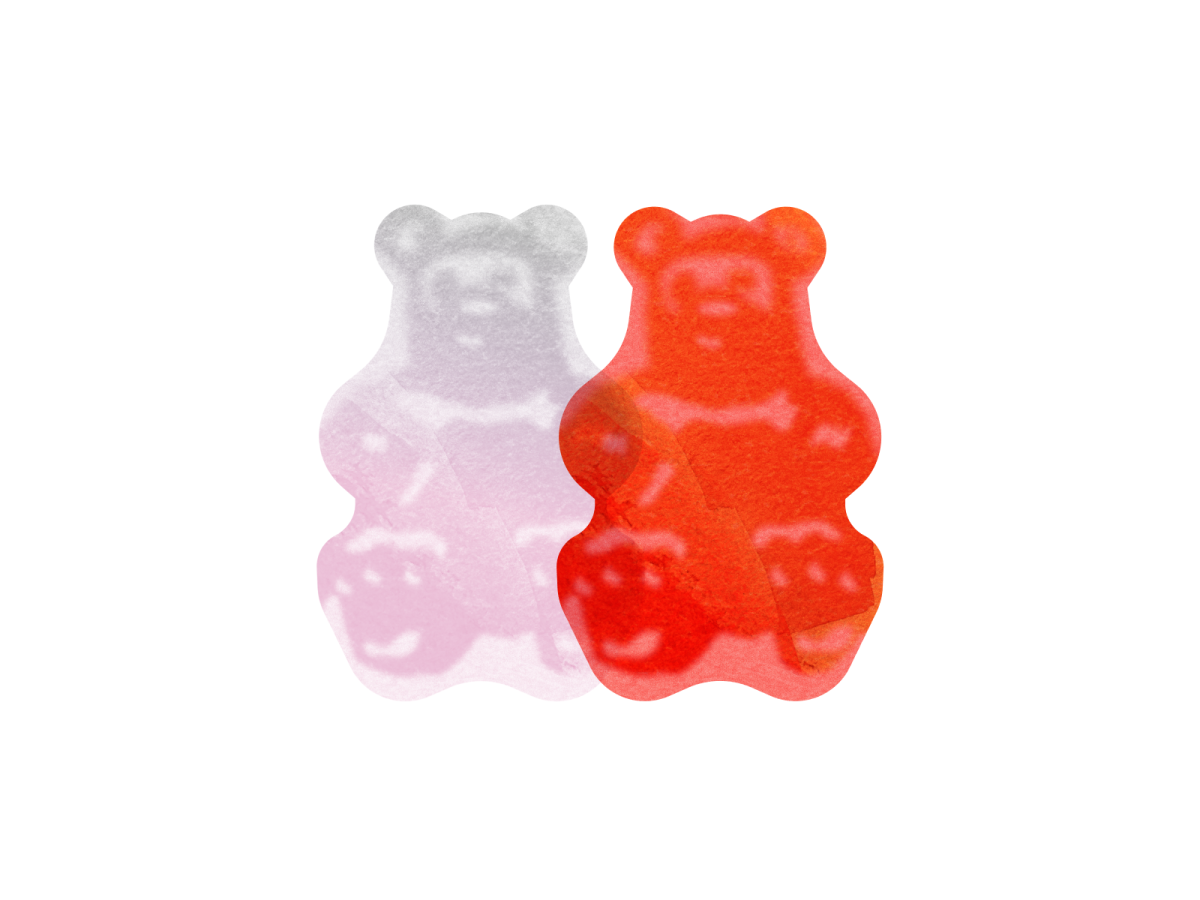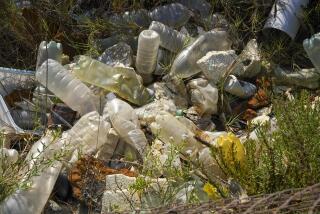So long, red dye No. 3? Why lawmakers want to cancel a chemical found in your Skittles and strawberry Yoohoo

- Share via
Skittles, strawberry Yoohoo and Walmart yogurt-dipped pretzels — what do these all have in common? They contain the controversial red dye No. 3 or titanium dioxide, which some California lawmakers are now waging war against.
A new bill could ban five chemicals prevalent in thousands of U.S. food items, including certain brands of fruit cups, sliced bread, fruit juice, cake mixes, trail mix and more.
Assembly Bill 418, introduced by Jesse Gabriel (D-Encino) and Buffy Wicks (D-Oakland), seeks to prohibit red dye No. 3 for good along with brominated vegetable oil, titanium dioxide, propylparaben and potassium bromate.
Red dye No. 3, a synthetic dye derived from petroleum, and titanium dioxide, which is a pigment often found in paint primer, are used for coloring food and are the most prevalent of the five proposed banned additives. The proposal cites a range of studies linking these additives to increased cancer risk, adverse behavioral development in children and decline in reproductive health, among other ailments; some studies tested their effects on humans, others on lab animals.
The legislators say they hope the bill, if passed, will inspire change nationally. And it could force food manufacturers to reformulate the ingredients in their products.
Los Angeles restaurants brace for new restrictions and fees in a proposed permanent Al Fresco dining ordinance.
Red dye No. 3 has been banned from cosmetics and select uses in the U.S. since 1990, but it’s still commonly found in food. All five of these additives have been banned from food use in the European Union.
“Unfortunately, the U.S. is really behind the rest of the world in protecting consumers from unsafe and toxic food chemicals,” said Gabriel. “In a lot of ways, the chemical companies get to grade their own homework.”
Chef and TV host Andrew Zimmern brought some celebrity wattage to a virtual news conference with lawmakers, where the bill was announced. “Everyone in America should be confident the food we bring into our homes and serve our families is safe,” Zimmern said, “and I say that as a parent of a child myself. But as we know, that’s not always the case.”
A representative for the Food and Drug Administration, which regulates color additives in the U.S., said that the FDA “routinely reviews new scientific information on the authorized uses of ingredients”; if those are deemed unsafe, the FDA can rescind its own approvals, alert the public and aid in recall efforts. Industry groups have maintained that red dye No. 3 is safe at the levels that people normally consume it.
Gabriel stressed that the bill does not seek to ban products outright. Instead, Gabriel, Wicks and representatives for the bill’s co-sponsors — including nonprofits Consumer Reports and the Environmental Working Group — said they hope that it will spur companies to alter their ingredients if the bill becomes law. Many manufacturers have already done so for products sold in the European Union, such as Skittles.
Some restaurants spent tens of thousands of dollars for outdoor dining pivots. AB 1217 could provide stability for those who could lose their permits — and investments — next year.
Consumers today can order Skittles and other such items that don’t contain red dye No. 3 from Europe. This is evidence that these five additives are unnecessary, said Scott Faber, EWG senior vice president of government affairs.
“As someone who worked for the food industry, the only reason that companies are fighting to preserve these chemicals is because it’s inconvenient to change their recipes,” Faber said. He previously served as head of government affairs for the Grocery Manufacturers Assn., now known as the Consumer Brands Assn.
The bill provides time for companies to change their recipes for sale in the state; if signed into law, the new regulation would not take effect until Jan. 1, 2025.
According to the EWG, red dye No. 3 appears in nearly 3,000 food products; the nonprofit’s running tally of items containing the additive includes Pop Tarts frosted confetti cake bites, Sara Lee brownies with sprinkles and SuperValu gummy bears, among hundreds of other items. Titanium dioxide helps to whiten foods such as Kroger fat-free half-and-half, Campbell’s Healthy Request chicken corn chowder and Little Debbie honey buns.

An emulsifier primarily found in citrus drinks, brominated vegetable oil keeps citrus flavoring from floating to the surface. Both potassium bromate and propylparaben are often found in baked goods, the former adding rise and strength to bread and pizza doughs, the latter serving as a preservative in items such as tortillas, honey buns and trail mix.
The EWG, Consumer Reports,d Wicks and Gabriel consulted more than two dozen peer-reviewed studies that found ties between the five additives and health concerns, including a 2022 investigation of titanium dioxide’s possible adverse effects on the human intestine; a 2002 study on propylparaben’s relation to a decrease in testosterone in rats; and a 1999 study that found potassium bromate produced tumors in rats, mice and hamsters.
“Each of these chemicals has well-documented health risks, including a higher risk of cancer, hyperactivity and other behavioral problems, harm to the nervous system and even damage to our DNA,” Zimmern wrote in his newsletter last week, recapping his virtual appearance. “Each is either already prohibited or restricted from use in processed food for sale in the EU. And notice their uses? Yup, primarily cheap goods that target our children.”
Due to studies finding links to cancer causation, certain forms of red dyes have been banned from cosmetics in the U.S. since 1990, and calls for prohibiting other uses of the dye continued throughout the decades. More recently, multiple organizations petitioned the state’s health department in December to administer warning labels on food that contains specific food dyes. The initiative began in part due to a 2021 California study on synthetic dyes’ neurobehavioral impacts on children, which found that “synthetic food dyes are associated with adverse neurobehavioral outcomes in children.”
“Because these products are so omnipresent in snack food and marketed so heavily in kids’ direction, our children are exposed at a higher risk than adults. That’s why this is really important,” Wicks said during the virtual news conference. “If the FDA is not going to keep our communities safe, then it’s up to us here in the states to take action and to take decisive and swift action on this.”
According to a representative for the FDA, while the FDA reviews ingredient petitions and manufacturer-provided evidence that additives are safe for consumption, the onus falls on manufacturers to ensure products’ safety.
“It’s important to underscore that food manufacturers are responsible for marketing safe foods,” the FDA representative told The Times. “The food industry has a legal responsibility to ensure the safety of the ingredients they use in foods before they go to market.”
The International Assn. of Color Manufacturers, a global trade organization that represents the color-additives industry, did not respond to requests for comment regarding the state’s proposed AB 418.
But in response to California’s 2021 report noting links between artificial food dyes and neurobehavioral problems in children, IACM’s public statement called the evidence “insufficient.”
In response to the European Commission’s ban of titanium dioxide as a food additive, IACM released public comment urging the commission to reconsider its decision; the European Food Safety Authority’s panel that informed the EU ban, IACM said, used nanomaterials that were not representative of titanium dioxide’s form and method used in human consumption, rendering the panel’s findings “not relevant.”
“Titanium dioxide has a long history of safe use as a color additive,” IACM’s statement read.
According to the Environmental Working Group, there are thousands of food additives we can ingest. And “the good news is that, in all likelihood, most of these chemicals are safe,” Faber told The Times. “When EWG and Consumer Reports looked at the 10,000 or so chemicals and the chemicals that had been banned in the EU and were still showing up in the U.S., we found five where there was such compelling evidence of harm that it made sense for the California Legislature to ban them.”
More to Read
Eat your way across L.A.
Get our weekly Tasting Notes newsletter for reviews, news and more.
You may occasionally receive promotional content from the Los Angeles Times.













